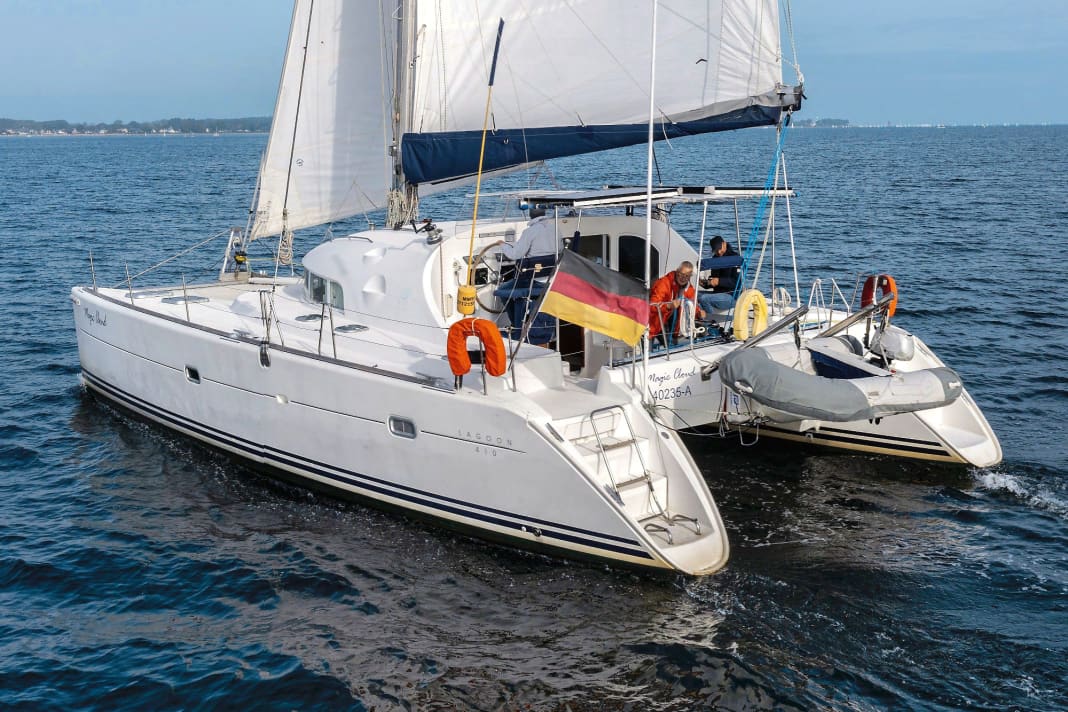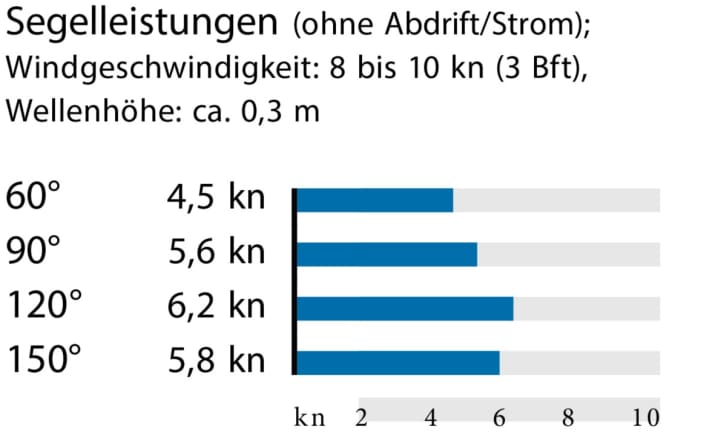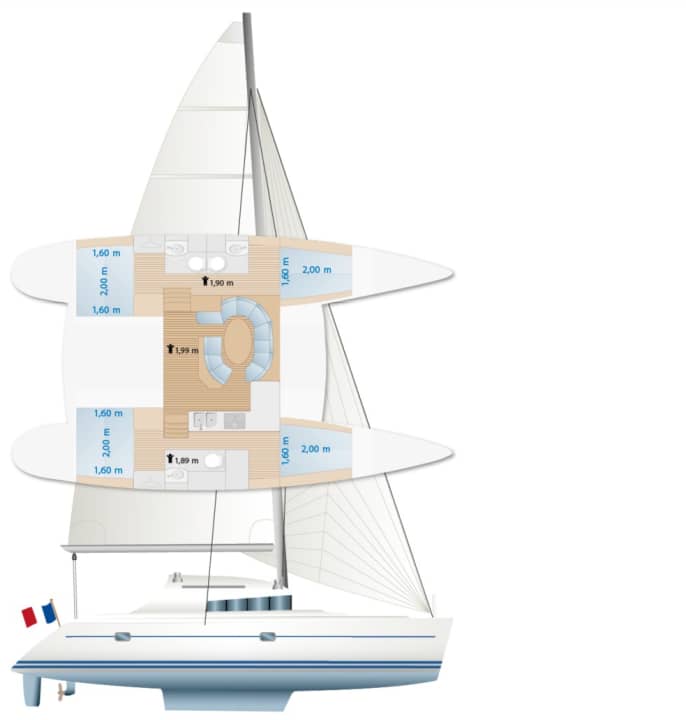Used boat test: Lagoon 410 - What can the pioneer of large series catamarans do?
Johannes Erdmann
· 02.12.2023






The striking wide and vertical window front makes the Lagoon 410 recognisable as such from afar. This was the trademark of Lagoon catamarans for many years. It was developed for purely practical reasons: The semi-circular windows were designed to maximise the space in the saloon and provide good all-round visibility.
The success story of the catamaran brand that now dominates the global market began in 1997 with the Lagoon 410. However, the history of Lagoon goes back much further. As early as the mid-1980s, a small group of Jeanneau employees began to open up a new branch and conquer the cruising catamaran market, which had previously been dominated by the British shipyard Prout, under the label JTA (Jeanneau Techniques Avancées). Under the leadership of Bruno Belmont, the development of the Lagoon 55 began as the first model in the new series. This was soon followed by the Lagoon 37, which was also produced in the USA as the 37 TPI. However, Lagoon preferred to focus on larger boats, launching the 42, 47, 57, 67 and 67S models on the market until 1994. Until the sale of the brand to the Beneteau Group heralded a turning point, during which the shipyard reconsidered which target group it actually wanted to reach.
With the Lagoon 410, the company finally developed a catamaran that it could build in large numbers and which, as a three- or four-cabin version, represented an optimal solution for both the charter market and for owners. One year later, the 410 was followed by its smaller brother, the Lagoon 380, which was to remain the world's most-built two-hull catamaran for a long time with a very similar appearance, even outlasting two successor generations and continuing to be built in parallel due to high demand.
Space miracle: Lagoon catamarans enjoyed a good reputation early on
When Johannes Frost from Kiel decided on his Lagoon 410 "Magic Cloud", the shipyard was already very successful, but not yet what the brand is today. In his younger years, Frost travelled a lot on the Baltic Sea in a folk boat, then as a young man as crew on the "Sea Cloud", which the name of his Lagoon still recalls today. "My first contact with a multihull was on a family cruise with a chartered ProutKat from Neustadt," says Frost. After that, he was hooked. He sailed with friends for many years and took part in the MC Cup on Mallorca several times to compare the individual catamarans directly. "I had decided on the type of catamaran, now it was just a question of which one." Johannes Frost spent three years comparing boats, even travelling across France by car to see the older generation of catamarans. "Casamance, Maldives, the whole range." But the boats built from the late nineties onwards were his favourite.
More exciting used boat tests:
"We made a list of criteria that the boat would have to fulfil," says Frost. These included, for example, the ability to lie in the cockpit. "But we never did that," he laughs. However, it was important to him to buy a mass-produced boat. "It always sells well, I thought to myself." Lagoon already had a good reputation back then and was known as a space miracle. "For cost reasons, we settled on the Lagoon 380," says Frost, even though his secret favourite was always the slightly larger 410. "It always sailed very far ahead at the MC Cup. We were allowed to look inside once and thought: 'Wow, that's awesome. What an incredible amount of space." When his "Magic Cloud" appeared on the market in 2007, Frost didn't hesitate for long. "I scraped all the money together and then said yes."
However, Johannes Frost was still a long way from the retirement that would allow him to travel extensively. That's why the first summer holidays took place on the Baltic Sea. "We travelled for three to six weeks, later alternating with friends, for example to Haparanda and back." He could not understand the reputation that there was no room for multihulls on the Baltic Sea.
The salon is huge, even by today's standards
Finally, in May 2012, Johannes Frost and his wife Angelika took a temporary break from their professional lives and embarked on a long voyage. By October, "Magic Cloud" had sailed via France and Spain to Portugal and in the following years sailed a large loop in the Mediterranean. In 2016, the crew finally made the leap across the pond, reaching the Caribbean and the USA, sailing up to New York and then back down south. From there, they returned to Kiel via Bermuda and the Azores in May 2019.
"The boat proved to be great on the long journey, and of course we really enjoyed all the space," reports Frost. Actually, they would have preferred to find an owner's version when looking for a boat, he admits. "But that meant we could take more friends and guests on board. That also had its advantages," he says. Although the cat is a four-cabin version, a concession was made to the owner's life, at least on the starboard side, and a large bathroom was installed. On the port side, however, there are two small ones.
The saloon, which tipped the scales in favour of the 410 for Frost, is huge even by today's standards. 4.30 metres wide and 3.45 metres long. Instead of the usual U-shaped sofa, the shipyard has fitted an almost O-shaped seating area, with a small sideboard in the entrance area. On the port side is a generous navigation corner with little space for charts, but plenty for instruments. To starboard is a large, L-shaped galley with a semi-cardanically suspended cooker. "The galley is nice and big," says Frost, "but my wife would sometimes have preferred an aft-facing galley, as is common on modern boats today. Then you simply take part in life in the cockpit a little more and aren't so isolated." A detail that was adapted in the later facelift version of the boat, the 410 S2, from model year 2005.
The owner has been travelling on the large series catamaran for 16 years
While the cabinets and doors in the saloon are made of light-coloured wood, large areas consist of a GRP inner shell. In contrast to the cabins, which are completely clad in wood. Unlike other ships of this age, which often have artificial leather or even carpet panelling on the walls, which often looks a little tatty after 20 years. The berths are very comfortable, measuring 2.00 metres by 1.60 metres both fore and aft. The headroom in the hulls is also sufficient at 1.85 to 1.90 metres, while the saloon is even suitable for taller crew members at 1.99 metres.
The engines, two good-sized Yanmar three-cylinder engines with 38 hp each, are located under the transversely installed double berths in the sterns. When developing the catamaran, the Lagoon crew thought ahead and provided covers in the deck above, which are sealed with sealant but can be removed when engines need to be replaced. "Back then, the drives were still built under the bunks," says Frost. Later, the designers envisaged separate engine compartments that were accessible from above and separated from the hull by a bulkhead. "So that you don't always have to fold up the whole bed, I split the covers over the engines," says Frost, describing one of the many small modifications he has carried out over 16 years.
The boat is robustly built and at the same time a fast and good sailor. That was the deciding factor in our purchase"
He sees one advantage of the machines under the bed in the fact that hardly any moisture or salt water gets to the motors. "After 23 years, they are still almost rust-free," he says. He has never noticed the smell of diesel in the bunk in all these years. "But I have separated the engine bilge from the main bilge so that leakage water, oil or diesel can never get into the main bilge." The 120-litre diesel tanks on the Lagoon 410 are located under the floor of the aft cabins. Frost has cut viewing windows into the stainless steel tanks and installed several filter systems to protect against diesel pest.
Small modifications to the Lagoon 410 make it even better
The owner has also made a few small changes to the deck and saloon over the years. "At the very beginning, I built a bimini myself, which is covered with a heavy lorry tarpaulin and has a fixed bar in the middle," says Frost. The original bimini simply consisted of a frame covered with tarpaulin fabric. "Now we can climb onto it safely to pack the sail. And we have more space for solar panels." Frost has managed to fit a total of 700 watts of panels. He gets by with that. The batteries are located in the bilge from the shipyard. "We moved them up into the saloon," says Frost, "and the cupboard for the gas bottles from the cockpit to the front in the anchor locker. Now not only Campingaz cylinders fit, but also larger ones."
Frost sees the main advantage of his boat as its durable construction. "The boat is really robust, but fast at the same time," he says. In contrast to later Lagoons, the steering position is halfway between the cockpit and the bimini. "I also prefer that to a flybridge, where you sit exposed and have hardly any contact with the crew." Frost is also delighted with the stable rig with a strong mast profile and the quality of the original equipment on his Lagoon. "We still have the original main halyard on it. There aren't enough signs of wear on the mantle for me to have to replace it," he says.
Frost does not see any major disadvantages to this type of boat. "A single-line reefing system would sometimes have been desirable," he says, which could certainly be retrofitted. "The bilges on the keels are a bit deep and difficult to keep clean," he adds, "and of course it squeaks and creaks in many corners in rough seas," he admits. But that's similar to other boats.
The Lagoon 410 is seaworthy and suitable for long journeys
On the other hand, Frost praises the good sea behaviour, especially on the return journey across the North Atlantic. "I think the boat has a good length in terms of sea behaviour. With a waterline of twelve metres, it sits well in the sea and runs at a hull speed of between eight and nine knots."
We were unable to verify this on the test day in the Kiel Fjord, as the wind was only eight to ten knots. However, this does not prevent the Lagoon 410 from travelling at between 4.5 and six knots with an angle to the wind of around 60 degrees. As the two wakes begin to roar more and more, owner Johannes Frost almost feels like letting the boat run a little again. "But I actually told myself that at the age of 67, I'm slowly shifting down a gear," he admits. He will no longer go on long trips with his "Magic Cloud". Instead, the couple are returning to the Baltic Sea. "In recent years, we've been to Bornholm, Stockholm and even southern Norway this year," says Johannes Frost. "But a Lagoon 410 really belongs on a long voyage. He showed us that."
The measured values from the Lagoon 410 test:


The Lagoon 410 in detail
Profile:
- Designer: VPLP
- Dimensions: 12.37 x 7.09 m
- Built by: 1997-2006
- Quantity: 280
- New price 1998: approx. € 253,245 (DM 495,305)
- Used price: approx. 200,000-235,000 €

Technical data:
- CE design category: A
- Total length: 12,37 m
- Waterline length: 11,67 m
- Width: 7,09 m
- Depth: 1,25 m
- Keel shape: short, moulded
- Mast height above WL: 18,29 m
- Theor. torso speed: 9.1 kn
- Weight: 7,2 t
- Mainsail: 56 m²
- Furling genoa: 38 m²
- Machine (Yanm.): 2x 29 kW/38 hp
- Fuel tanks (2): 240 l
- Fresh water tanks (2): 400 l
- Holding tanks (2): 200 l
Model history and design
The hull is a composite construction with balsa cores, solid under water. It is still extremely robust today. The 410 was available in various versions, with three to four cabins and two to four bathrooms. From 2005, it was replaced by the facelift version Lagoon 410 S2, the most striking difference being the larger hull windows.
Rig
The diamond rig with a pair of spreaders has a good profile strength and solid rigging.
Expansion
The Lagoon 410 impresses with a spaciousness that is rarely found on the market for its time.
Market situation
As the catamaran sold very well on the charter market, most boats today are ex-charter ships with four cabins. Owner's versions were rare back then and are very much in demand today. The boats are particularly common in the Mediterranean and the Caribbean, less so in northern Europe.
Pay attention to this
As with all boats with a balsa wood core, there is a risk of water penetrating the core. For this reason, all fittings on deck should be well-sealed to prevent problems caused by moisture.
Prices
- Standard price 1998: 495,305 DM
- Used price: 200.000-235.000 €
YACHT review Lagoon 410
The Lagoon 410 was a pioneer of large series construction. Robust, spacious and easy to sail, it offers an excellent overall package for catamaran beginners and long-distance sailors.
Design and concept
- + Good, functional layout
- + Solid construction
- + Exceptionally large lounge
Sailing performance and trim
- + Good sailing characteristics
- + Fast boat
- - Few trimming options
Living and finishing quality
- + Lots of wood in the interior fittings
- + Plenty of storage space
- + Very large pantry
Equipment and technology
- + Good quality of the equipment
- + Well dimensioned motors
- - Machines inside cabins

